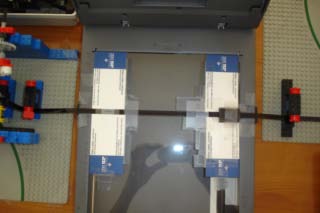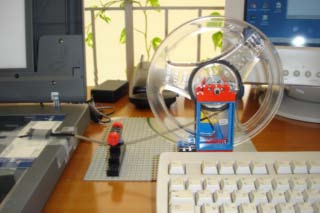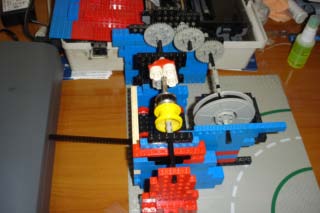| |
My 8mm telecine project
In summer 2005 I wanted to convert a bunch of old 8mm video rolls from my wife's childhood to DVD.
We first took the rolls to a video lab where they offer this service. However, we were not
satisfied with the outcome. The resolution was not close to the origin, the colors were much
more saturated than the original, and the quality of the VHS camcorder used in the conversion
process was evident in the DVD we got. Most disturbing of all, the video was cropped. Not just
a few pixels missing, but only about 75% of each original frame was visible after the transfer.
I think this is due to the different frame proportions of the different video standards involved
in the conversion process.
When we made some more inquiries, it turned out that
the lab we went to was actually the one many other photo labs send this kind of jobs to. So we
did not have many other options, certainly not cheap ones.
Looking for solutions on the internet I found
Richard J. Kinch's excellent description of his
Flatbed Scanner Digital Telecine Project .
I have decided to use the information provided on his website to build my own conversion machine.
For scanning the film I used an Epson 2480 flatbed scanner with 2400x4800 DPI resolution and
a built-in transparency unit providing backlight for scanning films. I used pieces of a transparency
film to direct the 8mm film to the specific location on the flatbed where I wanted to scan it.
Just like Kinch suggests
on his website, I've used a half broken Citizen dot matrix printer connected to my PC's parallel
port. I used some Lego Technic
wheels connected to one of the printers wheels to transmit the printer's motor motion. The Lego
wheels in turn were used to
rotate an 8mm sprocket I took from an old broken 8mm projector. This sprocket
had the film mounted on it and so when rotated it drove the film through the scanner.
The entire process was controlled by a small
Python program I wrote. Here is the place to tell everybody
how wonderful Python is.
If you know any programming language and haven't yet heard of Python yet,
go read about it now! Naturally, finding Python modules to handle parallel port and twain drivers
didn't take long, so I was able to directly control both the scanner and the printer from one small
program. So, once I placed a new film roll in place and managed to guide the beginning of the film
through its designated place on the scanner (which doesn't really take more than a minute), all I
needed was to press a button and wait. Yes, this is one of the major drawbacks of the machine. It is
slow. It took a little more than one minute to perform a single scan, which captures about 11 frames.
This means that scanning a film of about 4 minutes (18 frames per second) took about 7 hours...
But, if you are patient (or if you let your computer scan while you're not around) you end up with
many files consisintg of 11-12 consequtive frames each. To split these files into single frames
I have used a C program
I wrote (using a few components from Kinch's telecine software). After
finding the approximate size of frame and experimenting with different ways to identify the beginning
of a frame (finding sprocket holes, using the tiny black separators between frames) I managed to
come up with an automatic procedure that did the job.
I then used the JPGVideo freeware to
convert the thousands of single frames into an AVI video file. A friend of mine converted the files
to MPEG2 and burnt the dvd for me.
All in all, I've scanned about 50 rolls producing a little less than 3 hours of video. The quality
was much better than what we got from the video lab. Still, there is a lot that can be improved.
The scanning resolution is adequate, though having it doubled wouldn't be a bad idea. I think that with
this kind of high resolution one needs a better focusing mechanism. The scanner I used did not have an
adjustable focus mechanism. I know there are scanners that have this feature. Another problem is that
the film does not stay perfectly aligned when it is advanced. This causes a tiny, but sometimes
noticeable displacement between consecutive frames which were scanned together. Finding a better way for
keeping the film in place on the scanner glass may solve this problem. Finally, the speed (or lack of
it) issue. Much of the time was wasted on bringing the scanner's scanning head to the position of the
film in the beginning of each scan, and returning it back to place at the end of each scan. I did not
find a way to instruct the scanner to leave the scanning head where it was at the end of the scan.
Doing so would significantly decrease the time needed to scan a whole film.
The machine is no longer intact. I had to take it apart when we moved to Cambridge. Anyway, I don't
have any more rolls to convert. But, if anyone ever reads this and finds it helpful or interesting, I
would be glad to know. Do contact me if you have any questions or comments.
|
|





|
|





 cs
cs brown
brown